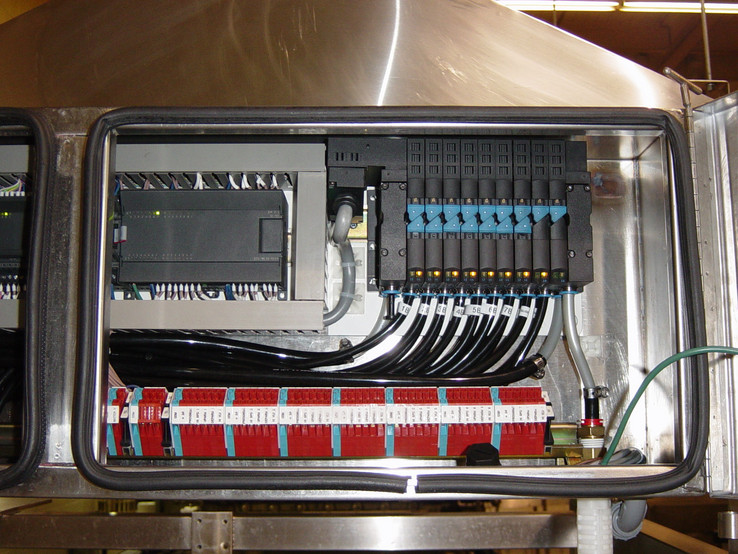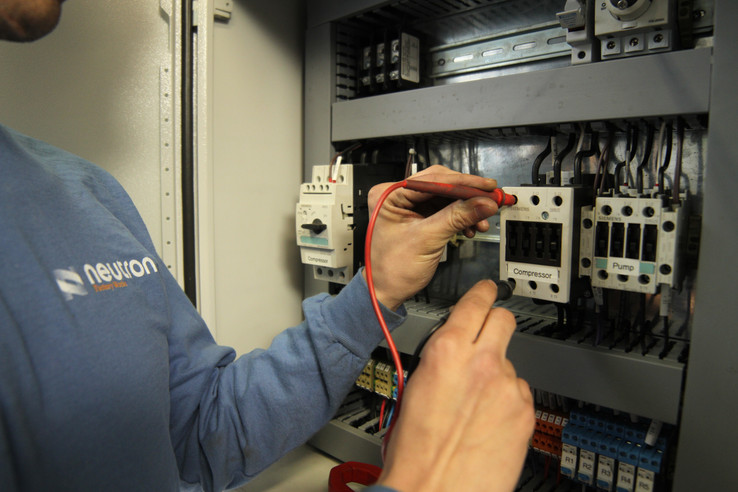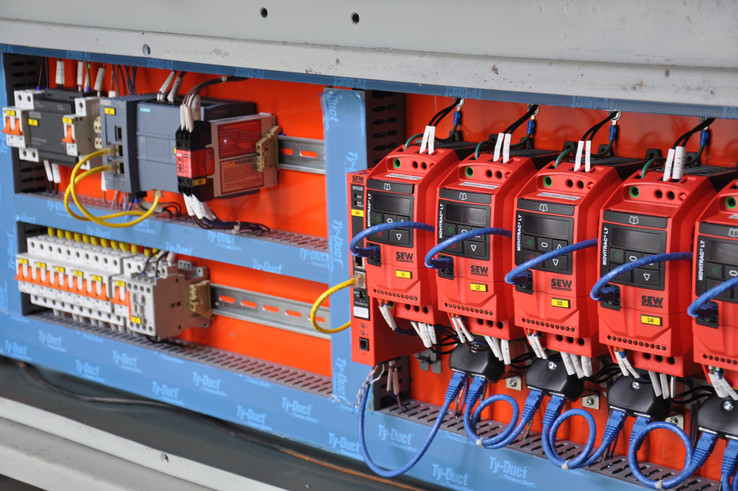Growing into a life-cycle provider
Neutron Factory Works, located in Greater Vancouver, British Columbia, is an award winning industrial contractor providing 24/7 services to manufacturing and processing facilities.
Neutron Factory Works, located in Greater Vancouver, British Columbia, is an award winning industrial contractor providing 24/7 services to manufacturing and processing facilities. While most of their customers are close by, some are as far away as Alaska and Japan. As part of their growth agenda, Neutron broadened its business to be a ‘full life cycle partner’ of customers, designing and installing entirely new systems that it also services. In support of that evolving strategy, Kris Morris, Neutron’s automation and panel shop manager, upgraded and standardized the drawing of schematics and other electrical engineering documentation by switching to EPLAN Electric P8. Neutron is the only industrial contractor in the Greater Vancouver area to provide electricians, refrigeration mechanics, welders and fabricators, millwrights and PLC programmers under one roof. Fast, around-the-clock service is Neutron’s calling card, even when the customer is a fishing boat in port with a refrigeration issue and a tight schedule. Neutron provides on-site trouble-shooting and repairs for electrical, automation, refrigeration and hydraulic/pneumatic machinery and systems, and develops preventative maintenance packages to minimize, even eliminate expensive downtime. British Columbia has a revenue-neutral carbon tax to encourage businesses and individuals to reduce their carbon footprint. That’s a growth opportunity for Neutron, which recently partnered with ‘Climate Smart’ to help customers implement CO2 reduction initiatives such as finding and repairing refrigerant leaks, installing air curtains and heat exchangers, upgrading lighting to LED fixtures and changing motor starters to variable frequency drives. Neutron sees great growth in helping customers incorporate more automation into their operations. Neutron presents a sound case for how even a basic EPLAN Electric P8 deployment – a single license - can help a business with a very small engineering department benefit from design automation. The company’s shift to EPLAN in 2014 had its genesis in what Kris Morris had observed over time in their customers’ facilities. On older equipment, he saw substandard or poorly drawn schematics, often none at all, which impacted the quality of the workmanship and made trouble-shooting more difficult. Sometimes, Morris’ assignment would even include reverse engineering an existing system. On the other hand, when he was examining electrical documentation for equipment from major overseas manufacturers, he was impressed by the high quality of the schematics – invariably done in EPLAN Electric P8.
EPLAN schematics set standard of excellence
“I was always happy when I saw a nice EPLAN set – the quality, the reliability, the ease of trouble-shooting,” he says. “I can read those schematics; I can find what I need to know quickly. I wanted us to put out schematics like that.” Morris also felt that adopting EPLAN schematics would make a strong statement to customers about the quality of Neutron’s work – while speeding the design process, improving product quality and facilitating service calls. Much of what Neutron designs and builds for customers are custom installations. Complete, accurate documentation can help a technician trouble-shoot and repair an issue faster, minimizing lost production time and the economic hit from idle equipment and missed delivery deadlines. Kris now ensures all of their schematics are completed in EPLAN, so his colleagues can seamlessly complete the programming and panel construction. In the past, schematics were done in AutoCAD or Constructor, but whatever the drawing method, creating schematics “was just slow and cumbersome, in order to increase our efficiency, EPLAN was an obvious choice.” says Morris. After less than a year using EPLAN exclusively, Neutron has seen a huge productivity improvement. Panel-building accuracy is greatly improved. The assembly process for manual or CAD drawings used to feature inaccurate placement of components, requiring lots of adjustments before the job was finished. “Things were constantly shifting. I used to have to ensure every wire I connected was left with a big loop, so I could move stuff around later if required…no longer!” EPLAN drawings are professional, precise, with greater detail and specificity. Revisions can be applied quickly, and all data updates automatically. No longer is panel assembly subject to make-it-up-as-you-go changes. With EPLAN, wire lists and labels and parts lists are generated automatically. “For larger sized panels,” says Morris, “manual label and list generation used to take 3-4 hours and had about a 5% data-entry error rate. It now takes about 20 minutes.” Overall, he estimates the entire panel making design/build process is roughly 200% faster now, with an even larger magnitude of improvement for the quality of the finished product. Morris is creating all projects to IEC standards, making good use of baseline EPLAN automation features such as auto-connect and automatic error correction and cross-referencing. As a small company and new EPLAN user, Neutron is progressively scaling up its EPLAN capability. Morris is using the EPLAN Data Portal to import parts data and parts macros for recurrent usage items like controls transformers, and has created content many macros for motor control circuits and more. As the engineering workload continues to grow with larger orders, Morris plans to hire a junior engineer to take over the creation of schematics, and possibly add EPLAN products like EPLAN Fluid. “EPLAN has allowed Neutron to build and deliver quality products reliably, on time and on budget. I want to create a culture where this is what every customer expects, and exactly what we deliver on, every time.” says Morris.
Summary Neutron Factory Works
Many of Neutron Factory Works’ customers can lose thousands of dollars a minute from unscheduled maintenance downtime. Neutron is set up to respond efficiently and effectively across all their departments, to get customers up and running again as fast as possible. Neutron’s field team of electricians and automation technicians are often faced with poor quality schematics, making equipment trouble-shooting extremely difficult. At the same time, the quality of EPLAN schematics provided by some overseas equipment makers was excellent, a pleasure to use. Neutron adopted EPLAN Electric P8 for its own control panel schematics to design them faster and to make a better quality product than had been possible using AutoCAD or Constructor. The result? After less than a year of using EPLAN, panel design efficiency had doubled, and quality of control systems was taken to new heights. EPLAN schematics make a strong statement about the quality Neutron delivers. Find out more about Neutron Factory Works at <link http: www.neutronfactoryworks.com _blank external-link-new-window external link in new>www.neutronfactoryworks.com.
Neutron Factory Works, located in Greater Vancouver, British Columbia, is an award winning industrial contractor providing 24/7 services to manufacturing and processing facilities. While most of their customers are close by, some are as far away as Alaska and Japan. As part of their growth agenda, Neutron broadened its business to be a ‘full life cycle partner’ of customers, designing and installing entirely new systems that it also services. In support of that evolving strategy, Kris Morris, Neutron’s automation and panel shop manager, upgraded and standardized the drawing of schematics and other electrical engineering documentation by switching to EPLAN Electric P8. Neutron is the only industrial contractor in the Greater Vancouver area to provide electricians, refrigeration mechanics, welders and fabricators, millwrights and PLC programmers under one roof. Fast, around-the-clock service is Neutron’s calling card, even when the customer is a fishing boat in port with a refrigeration issue and a tight schedule. Neutron provides on-site trouble-shooting and repairs for electrical, automation, refrigeration and hydraulic/pneumatic machinery and systems, and develops preventative maintenance packages to minimize, even eliminate expensive downtime. British Columbia has a revenue-neutral carbon tax to encourage businesses and individuals to reduce their carbon footprint. That’s a growth opportunity for Neutron, which recently partnered with ‘Climate Smart’ to help customers implement CO2 reduction initiatives such as finding and repairing refrigerant leaks, installing air curtains and heat exchangers, upgrading lighting to LED fixtures and changing motor starters to variable frequency drives. Neutron sees great growth in helping customers incorporate more automation into their operations. Neutron presents a sound case for how even a basic EPLAN Electric P8 deployment – a single license - can help a business with a very small engineering department benefit from design automation. The company’s shift to EPLAN in 2014 had its genesis in what Kris Morris had observed over time in their customers’ facilities. On older equipment, he saw substandard or poorly drawn schematics, often none at all, which impacted the quality of the workmanship and made trouble-shooting more difficult. Sometimes, Morris’ assignment would even include reverse engineering an existing system. On the other hand, when he was examining electrical documentation for equipment from major overseas manufacturers, he was impressed by the high quality of the schematics – invariably done in EPLAN Electric P8.
EPLAN schematics set standard of excellence
“I was always happy when I saw a nice EPLAN set – the quality, the reliability, the ease of trouble-shooting,” he says. “I can read those schematics; I can find what I need to know quickly. I wanted us to put out schematics like that.” Morris also felt that adopting EPLAN schematics would make a strong statement to customers about the quality of Neutron’s work – while speeding the design process, improving product quality and facilitating service calls. Much of what Neutron designs and builds for customers are custom installations. Complete, accurate documentation can help a technician trouble-shoot and repair an issue faster, minimizing lost production time and the economic hit from idle equipment and missed delivery deadlines. Kris now ensures all of their schematics are completed in EPLAN, so his colleagues can seamlessly complete the programming and panel construction. In the past, schematics were done in AutoCAD or Constructor, but whatever the drawing method, creating schematics “was just slow and cumbersome, in order to increase our efficiency, EPLAN was an obvious choice.” says Morris. After less than a year using EPLAN exclusively, Neutron has seen a huge productivity improvement. Panel-building accuracy is greatly improved. The assembly process for manual or CAD drawings used to feature inaccurate placement of components, requiring lots of adjustments before the job was finished. “Things were constantly shifting. I used to have to ensure every wire I connected was left with a big loop, so I could move stuff around later if required…no longer!” EPLAN drawings are professional, precise, with greater detail and specificity. Revisions can be applied quickly, and all data updates automatically. No longer is panel assembly subject to make-it-up-as-you-go changes. With EPLAN, wire lists and labels and parts lists are generated automatically. “For larger sized panels,” says Morris, “manual label and list generation used to take 3-4 hours and had about a 5% data-entry error rate. It now takes about 20 minutes.” Overall, he estimates the entire panel making design/build process is roughly 200% faster now, with an even larger magnitude of improvement for the quality of the finished product. Morris is creating all projects to IEC standards, making good use of baseline EPLAN automation features such as auto-connect and automatic error correction and cross-referencing. As a small company and new EPLAN user, Neutron is progressively scaling up its EPLAN capability. Morris is using the EPLAN Data Portal to import parts data and parts macros for recurrent usage items like controls transformers, and has created content many macros for motor control circuits and more. As the engineering workload continues to grow with larger orders, Morris plans to hire a junior engineer to take over the creation of schematics, and possibly add EPLAN products like EPLAN Fluid. “EPLAN has allowed Neutron to build and deliver quality products reliably, on time and on budget. I want to create a culture where this is what every customer expects, and exactly what we deliver on, every time.” says Morris.
Summary Neutron Factory Works
Many of Neutron Factory Works’ customers can lose thousands of dollars a minute from unscheduled maintenance downtime. Neutron is set up to respond efficiently and effectively across all their departments, to get customers up and running again as fast as possible. Neutron’s field team of electricians and automation technicians are often faced with poor quality schematics, making equipment trouble-shooting extremely difficult. At the same time, the quality of EPLAN schematics provided by some overseas equipment makers was excellent, a pleasure to use. Neutron adopted EPLAN Electric P8 for its own control panel schematics to design them faster and to make a better quality product than had been possible using AutoCAD or Constructor. The result? After less than a year of using EPLAN, panel design efficiency had doubled, and quality of control systems was taken to new heights. EPLAN schematics make a strong statement about the quality Neutron delivers. Find out more about Neutron Factory Works at <link http: www.neutronfactoryworks.com _blank external-link-new-window external link in new>www.neutronfactoryworks.com.




